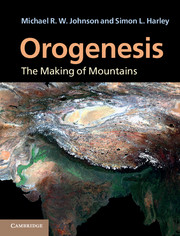Book contents
- Frontmatter
- Contents
- Preface
- Acknowledgments
- Geological timescale
- 1 Major features of the Earth and plate tectonics
- 2 Driving mechanisms for plates, slab retreat and advance, and a cause of orogenesis
- 3 Physical and chemical principles: rock deformation, isostasy, geochronology and heat production in the lithosphere
- 4 Large-scale features of orogens: thrusts and folds
- 5 Evolution of orogens
- 6 Lateral spreading of orogens: foreland propagation, channel flow and weak zones in the crust
- 7 Metamorphism in orogeny
- 8 The erosion and exhumation of mountains
- 9 Sedimentary history of the foredeep basins
- 10 Deep structure, mountain support and phase changes
- 11 Mountains and climate
- 12 Secular change in orogeny
- References
- Index
- Plate section
- References
12 - Secular change in orogeny
Published online by Cambridge University Press: 05 June 2012
- Frontmatter
- Contents
- Preface
- Acknowledgments
- Geological timescale
- 1 Major features of the Earth and plate tectonics
- 2 Driving mechanisms for plates, slab retreat and advance, and a cause of orogenesis
- 3 Physical and chemical principles: rock deformation, isostasy, geochronology and heat production in the lithosphere
- 4 Large-scale features of orogens: thrusts and folds
- 5 Evolution of orogens
- 6 Lateral spreading of orogens: foreland propagation, channel flow and weak zones in the crust
- 7 Metamorphism in orogeny
- 8 The erosion and exhumation of mountains
- 9 Sedimentary history of the foredeep basins
- 10 Deep structure, mountain support and phase changes
- 11 Mountains and climate
- 12 Secular change in orogeny
- References
- Index
- Plate section
- References
Summary
Previous chapters have outlined the principles underpinning the understanding and analysis of orogenic belts in the modern world, with examples and applications to the Alps, the Himalaya, the Andes and western North America. We have also used examples from earlier times in Earth history to illuminate the issues surrounding, for example, the processes of thrust tectonics, metamorphism at extreme conditions, variability in exhumation rates, and contrasts in the amounts of magmatism in collisional and accretionary orogens. In doing this we have presented evidence from Palaeozoic orogens, such as the Variscan/Hercynian and Caledonian, Neoproterozoic orogens including the ‘Pan African’ belts of former Gondwanan fragments in India, Africa and Antarctica, and Mesoproterozoic orogens such as the Grenville of northeastern America. This begs the simple question – can we look back in time and see similarities in orogeny and the making of mountains throughout Earth history, or has mountain building changed in subtle or even dramatic ways since the earliest records of continental crust, deformation and metamorphism? In other words, has there been secular change in orogeny? Within the context of the recognised diversity in Phanerozoic orogenies, were Archaean and Proterozoic orogenies broadly the same, or different?
The question of secular change in mountain building has been the subject of considerable debate and a burgeoning literature. It forms part of the broader issue of the extent to which uniformitarianism can be applied far back in time – whether ‘the present is the key to the past’. Recent major volumes on the subject include Ancient Orogens and Modern Analogues (Murphy et al., 2009) and When did Plate Tectonics Begin on Planet Earth? (Condie & Pease, 2008). These build on an extensive literature in which the temporal evolution of the Earth's tectonic regime has been assessed or speculated upon using thermal and geodynamic modelling, geological observations from ancient and modern terrains, and geochemical and isotopic constraints on rates of continental growth through time (e.g. Hawkesworth & Kemp, 2006a, b; Kemp et al., 2007) (see Fig. 12.5 later).
- Type
- Chapter
- Information
- OrogenesisThe Making of Mountains, pp. 322 - 342Publisher: Cambridge University PressPrint publication year: 2012



